Daniel Sherrier's Blog, page 27
October 18, 2016
Today’s Super Comic — All-New Hawkeye #6 (2016)
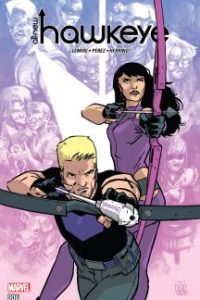 The Jeff Lemire/Ramon Perez run on All-New Hawkeye comes to a satisfying conclusion in #6 (which should really be #11, but maybe smaller numbers sell better).
The Jeff Lemire/Ramon Perez run on All-New Hawkeye comes to a satisfying conclusion in #6 (which should really be #11, but maybe smaller numbers sell better).
The issue’s highlight is the flashback showing the moment when the Avengers, particularly Hawkeye, first inspired the second Hawkeye, Kate Bishop. And the scene is nicely placed after an amusing present-day conversation between Clint Barton and his brother Barney, in which Barney rags on him for being the Avengers’ token normal guy. But Hawkeye’s ability to hold his own among Earth’s Mightiest Heroes without any powers, just a bow and arrows and skills—that’s what inspires young Kate.
The unconventional friendship between the two Hawkeyes has formed a great heart for the series, and it pays off wonderfully here.
Writer: Jeff Lemire
Artist: Ramon Perez
Publisher: Marvel Comics
How to Read It: recent back issues; Marvel Unlimited; Comixology; included in Hawkeye vol. 6: Hawkeyes (TPB)
Appropriate For: ages 13 and up
October 17, 2016
Today’s Super Comic — Guardians of the Galaxy #1 (2015)
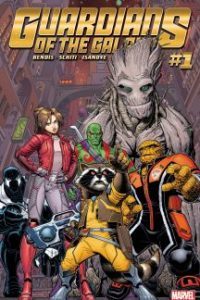 I’m still not a fan of Marvel’s habit of renumbering their titles every couple of years or so. But if they must, this was a reasonably appropriate point to give Guardians of the Galaxy a fresh start.
I’m still not a fan of Marvel’s habit of renumbering their titles every couple of years or so. But if they must, this was a reasonably appropriate point to give Guardians of the Galaxy a fresh start.
A few months or so have passed since the conclusion of the previous series, and the Guardians’ lineup continues to add representatives from various regions of the Marvel Universe. They’ve had Spider-Man’s Venom (Flash Thompson) for a while. The X-Men’s Kitty Pryde joined late in the previous run. And now the Fantastic Four’s Thing has left Earth and begun guarding the galaxy (if you want to know what time it is in space, he’ll be happy to answer). Combined with the Guardians’ regulars, this series should never lack for clever banter.
And meanwhile, Peter Quill is king of Spartax, which isn’t the most suitable role for him, thereby producing an entertaining situation for the reader.
I liked the previous series, but I’m greatly enjoying this latest iteration. The humor is stronger, the action is more fun, and the cosmic plots feel more exciting. Now if only there was some way to work in a ‘70s soundtrack, we’d be all set.
Writer: Brian Michael Bendis
Artist: Valerio Schiti
Publisher: Marvel Comics
How to Read It: back issues; Marvel Unlimited; Comixology; included in Guardians of the Galaxy: The New Guard, Vol. 1: Emperor Quill (TPB)
Appropriate For: ages 12 and up
October 16, 2016
Today’s Super Comic — The Sandman #8 (1989)
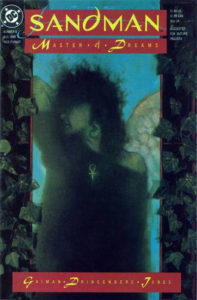 There are lots of ways for a character to make a great first impression on me. One foolproof way is by referencing Mary Poppins.
There are lots of ways for a character to make a great first impression on me. One foolproof way is by referencing Mary Poppins.
And that’s how we meet The Sandman’s personification of death. In Neil Gaiman’s world, Death appears as a lively teenaged girl, and she’s the older sister of the series’ protagonist, Dream. No Grim Reaper clichés here.
Death debuts in #8, which is when the series truly started becoming amazing. Dream has just completed a quest that defined the series’ opening arc, and now he’s feeling adrift and purposeless. So his sister comes along to check on him, and he tags along as she goes about her routine of guiding the newly deceased into the afterlife, reminding Dream of his own responsibilities. Gaimain makes the right call in not showing us Death’s realm; instead, we just see her kindness and tact as she greets diverse people who are all about to embark on the same journey.
It’s an excellent issue that stands on its own while also promising the greatness to come throughout the rest of the series…and the also-excellent Death spinoff miniseries.
Writer: Neil Gaiman
Artist: Mike Dringenberg
Inker: Malcolm Jones III
Publisher: DC Comics (Vertigo)
How to Read It: back issues; Comixology; included in The Sandman vol. 1: Preludes & Nocturnes (TPB)
Appropriate For: ADULTS ONLY
October 15, 2016
Today’s Super Comics — Batman and the Outsiders #1-2 (1983)
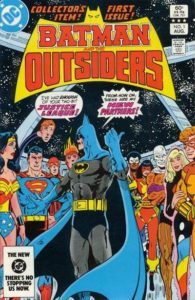 The early ‘80s was a golden age for team books. Uncanny X-Men, The New Teen Titans, The Avengers, and Justice League of America were all putting out excellent stuff at the time. But that clearly wasn’t enough, so along came Batman and the Outsiders.
The early ‘80s was a golden age for team books. Uncanny X-Men, The New Teen Titans, The Avengers, and Justice League of America were all putting out excellent stuff at the time. But that clearly wasn’t enough, so along came Batman and the Outsiders.
The series was built in the same mold as New Teen Titans, but with mostly adults. It took a few established characters (Batman, Black Lightning, and Metamorpho) and teamed them up with a few newcomers (Halo, Katana, and Geo-Force), and the stories drew inspiration from the characters’ diverse backgrounds while the reader had fun watching these distinct personalities interact. The main difference was that one character got top billing, and of course he did, because he’s Batman.
The team forms in the first two issues, and it comes together organically, with each character drawn to the conflict for his or her own reason. Batman has a nice little mini-arc, as he swiftly progresses from team member to loner to team leader.
Batman’s resignation from the Justice League is particularly well done. Bruce Wayne’s right-hand man, Lucius Fox, gets kidnapped in the war-torn country of Markovia while on business, so naturally Batman wants to gather his JLA teammates and stage a rescue. But the JLA’s hands are tied—the State Department fears the Markovian situation would escalate if troops or superheroes got involved, so Superman promised the JLA wouldn’t intervene. But Batman has a friend to save, so if the JLA’s rules get in the way, then it’s time to quit the JLA and go save his friend.
The scene illustrates how Batman’s morality is either more complex or more simplistic than the rest of the League’s, depending on your point of view…which in turn demonstrates how comics were beginning to tackle more mature themes at this point (while remaining appropriate for and still largely aimed at kids).
If you’ve enjoyed other ‘80s team books, this one’s well worth tracking down, too.
Writer: Mike W. Barr
Artist: Jim Aparo
Publisher: DC Comics
How to Read It: back issues; Comixology; included in Showcase Presents: Batman and the Outsiders vol. 1 (TPB)
Appropriate For: ages 10 and up
October 14, 2016
Today’s Super Comics — JLA #16-17 (1998)
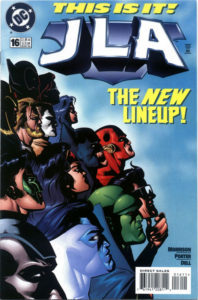 The Justice League and the Avengers love changing their lineups. It’s a staple of both franchises. They also both like to shake up their rosters in issue #16, apparently. But whereas the original Avengers #16 replaced the old guard with mostly new members, the ‘90s Justice League reboot instead doubles its membership in JLA #16.
The Justice League and the Avengers love changing their lineups. It’s a staple of both franchises. They also both like to shake up their rosters in issue #16, apparently. But whereas the original Avengers #16 replaced the old guard with mostly new members, the ‘90s Justice League reboot instead doubles its membership in JLA #16.
So we’ve got fourteen JLAers, plus the party-crashing Catwoman, and about a hundred reporters aboard the Justice League’s moon-based headquarters. And of course a new villain strikes and starts taking the team down one member at a time.
This villain, Prometheus, instantly appears to be a formidable and credible threat. His motivation is sketchy, but in writer Grant Morrison’s defense, he is juggling a ton of characters in the course of two issues and still manages to give everyone time in the spotlight.
The plot is pretty basic, but it’s really all about showing off the new team and introducing a highly skilled and intelligent new villain to DC’s ranks. And in that regard, it succeeds in being tremendous fun. Prometheus may be underdeveloped here, but he certainly shows potential. Maybe one of those CW shows might want to consider using him. Just a totally random thought there.
Writer: Grant Morrison
Pencilers: Howard Porter and Arnie Jorgensen
Inkers: John Dell and David Meikis & Mark Pennington
Publisher: DC Comics
How to Read It: back issues; Comixology; included in JLA: The Deluxe Edition vol. 2 (TPB)
Appropriate For: ages 11 and up
October 13, 2016
Today’s Super Comic — New Avengers Annual #1 (2006)
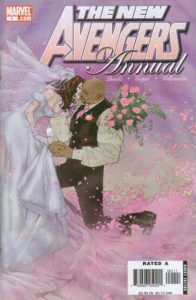 Sweet Christmas, that Luke Cage Netflix series was excellent. So was the Jessica Jones series.
Sweet Christmas, that Luke Cage Netflix series was excellent. So was the Jessica Jones series.
And oh, look, here are they both are in comic book form…getting married. That’s nice for them.
New Avengers Annual #1 is a good example of how to do a wedding issue right—basically, have the wedding itself take up very little of the overall comic. A full-length wedding issue is almost a no-win situation in superhero comics. Super-villains could crash the festivities, and they have, but that’s far too predictable these days. The ceremony could proceed smoothly, which has also been done, and while it’s nice to see likeable characters interact in a happy setting, it tends to be a tension-free affair.
So despite the wedding-themed cover, this annual largely focuses on an unrelated battle between the Avengers and an especially powerful foe, as they employ both brains and brawn to take her down. The battle ties into ongoing arcs and it’s a fun romp on its own.
As for Luke/Jessica, their relationship had evolved since Jessica’s introduction a few years earlier, and the wedding ceremony is merely the epilogue to an arc that had already reached a satisfactory conclusion. They have a nice ceremony surrounded by friends, and Jessica has her moment to be Jessica (written perfectly in character, of course, with the character’s creator writing the issue). And you have an entertaining, notable annual that shows how comic book characters’ lives aren’t static like they were in the olden days.
And nice Stan Lee cameo, by the way.
Writer: Brian Michael Bendis
Penciler: Olivier Coipel
Publisher: Marvel Comics
How to Read It: back issues; Marvel Unlimited; Comixology
Appropriate For: ages 12 and up
October 12, 2016
Today’s Super Comic — Runaways #9 (2004)
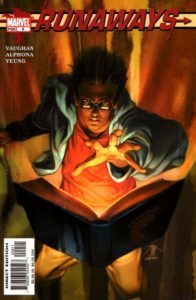 Yeah, I’m still re-reading Runaways. I was overdue for it.
Yeah, I’m still re-reading Runaways. I was overdue for it.
The action takes a break in #9, and we get an issue of the kids hanging out in their new hideout…with a guest, a teen they recently met who’s also eager to escape his evil parents. What a coincidence! Of course, this being a story, the odds of a new character not introducing conflict are slim. And remember one of those great Pixar rules—coincidences are great for getting characters into trouble, not out of trouble.
Meanwhile, the evil parents continue searching for their kids. What distinguishes this from the typical villains-pursuing-heroes fare is that they actually do care about their kids. Their judgment is clearly atrocious or they wouldn’t be villains, but like all parents, they desire only the best for their children.
And if you ever want to study up on amazing cliffhangers, this series has some lessons for you.
Writer: Brian K. Vaughan
Penciler: Adrian Alphona
Inker: Craig Yeung
Publisher: Marvel Comics
How to Read It: back issues; Marvel Unlimited; Comixology; included in Runaways vol. 2: Teenage Wasteland (TPB)
Appropriate For: ages 12 and up
October 11, 2016
Today’s Super Comic — Kingdom Come #4 (1996)
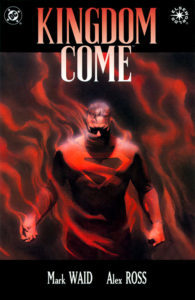 Kingdom Come arrives at a perfect conclusion.
Kingdom Come arrives at a perfect conclusion.
The Superman in this miniseries has been one who’s lost his way. He still wants to do the right thing, but his previously impeccable judgment is impaired. This is the issue to address how he let that happen and how to right the course…but only after he reaches his breaking point, brought upon in part by his own incredible sense of responsibility.
Wonder Woman, too, has strayed, and her arc comes to a head in an excellent confrontation with Batman. And Captain Marvel is extremely well cast as the one character who is both superhuman and human.
The two-page spread early in the book showcases Alex Ross’s amazing artistic talents. He crams so many characters on the battlefield, with every bit player and background actor engaged in a specific action against a specific opponent. Throughout the book, each page is a phenomenal work of art.
Writer Mark Waid clearly understands superheroes’ two most important roles—to fight always for life, and to inspire. Unless they do those two things, they’re not truly superheroes. This series is ultimately all about superheroes becoming heroic again, and while I’ve never ranked my favorite comics, Kingdom Come would easily fall in the top ten. Probably top five.
Writer: Mark Waid
Artist: Alex Ross
Publisher: DC Comics
How to Read It: back issues; Comixology; included in Kingdom Come (TPB)
Appropriate For: ages 12 and up
October 10, 2016
Today’s Super Comic — Kingdom Come #3 (1996)
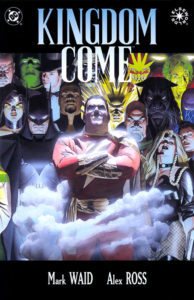 In the third issue of Kingdom Come, Superman doesn’t want to adjust to a changing world, but Captain Marvel couldn’t adjust. Superman strives to maintain peace, but Wonder Woman is prepared for war, if necessary.
In the third issue of Kingdom Come, Superman doesn’t want to adjust to a changing world, but Captain Marvel couldn’t adjust. Superman strives to maintain peace, but Wonder Woman is prepared for war, if necessary.
The inclusion of Captain Marvel (Shazam) is an excellent choice. He truly is DC’s most innocent superhero. He’s a child who can transform into a super-powered adult, but he’s still a child at heart. But this miniseries is set in the future, and Billy Batson is all grown up…and the manner in which he’s grown up reflects the world around him. He simply doesn’t fit in this darker age, leading him into Lex Luthor’s thrall. His cheesy smile has never been creepier.
The conflict between Superman’s idealism and Wonder Woman’s pragmatism is especially well-handled, and it’s all the more interesting because it’s a conflict between two people who respect each other a great deal.
Tensions escalate throughout the issue. We get some relief as Batman has his Awesome Batman Moment. But this is all about putting all the chess pieces in place for the climactic battle, and it features many excellent moments along the way, including this fantastic quote from Superman to Batman:
“The deliberate taking of human—even super-human—life goes against every belief I have—and that you have. That’s the one thing we’ve always had in common. It’s what made us what we are.”
I will savor re-reading the final issue.
Writer: Mark Waid
Artist: Alex Ross
Publisher: DC Comics
How to Read It: back issues; Comixology; included in Kingdom Come (TPB)
Appropriate For: ages 12 and up
October 9, 2016
Today’s Super Comic — Kingdom Come #2 (1996)
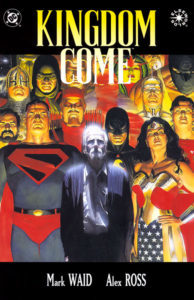 Another issue that’s just as good, if not better than I remember.
Another issue that’s just as good, if not better than I remember.
This is the “gathering of forces” issue. Superman rebuilds the Justice League. Batman and a few other non-powered ex-Leaguers make their own appeal to the younger generation. Lex Luthor and a cabal of old villains are up to something. And the antiheroes continue to do whatever they damn well please…but with significantly tougher opposition now.
The key to the issue’s success is the focus on varying worldviews. Superman and Batman’s argument, which involves not a single punch or blast of heat vision, is far more compelling than anything seen in the Batman v Superman movie. Wonder Woman, who’s serving as Superman’s right hand, also sees things differently than the Man of Steel due to her experience as a warrior.
And then there’s Magog, the “superhero” who precipitated Superman’s retirement. Magog took it upon himself to kill, rather than apprehend, the Joker; Superman wouldn’t stand for such a blatant disregard for the law and human decency, so he took Magog to court. And Metropolis and its citizens sided overwhelmingly with Magog. He was the future, and Superman was the past.
But “new” doesn’t always equal “right,” and as we saw in #1, Magog’s carelessness resulted in the deaths of a million innocents. And his genuine remorse in this issue adds just enough depth to his character.
“They chose the man who would kill over the man who wouldn’t,” Magog says, “and now they’re dead.”
As I suggested yesterday, this is one of the greatest Superman stories ever told.
Writer: Mark Waid
Artist: Alex Ross
Publisher: DC Comics
How to Read It: back issues; Comixology; included in Kingdom Come (TPB)
Appropriate For: ages 12 and up



